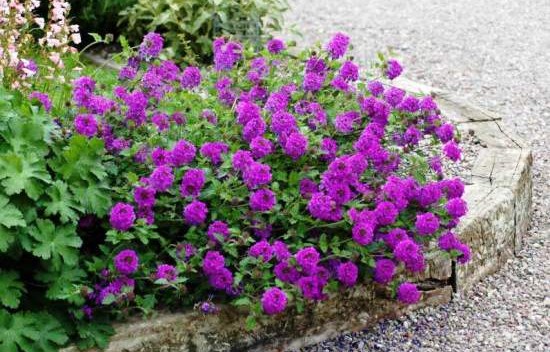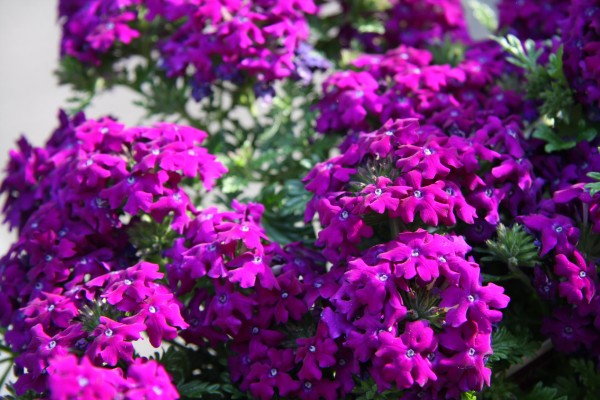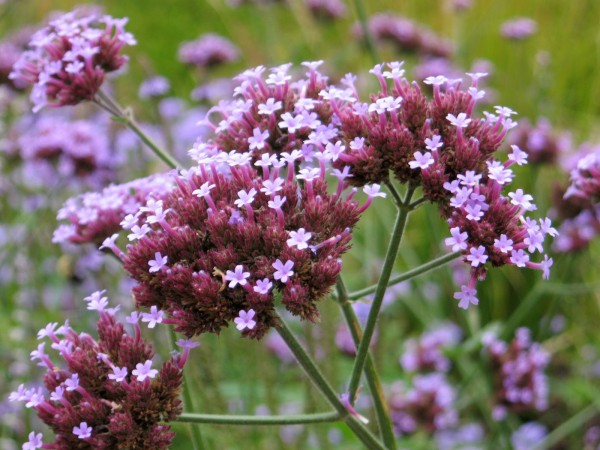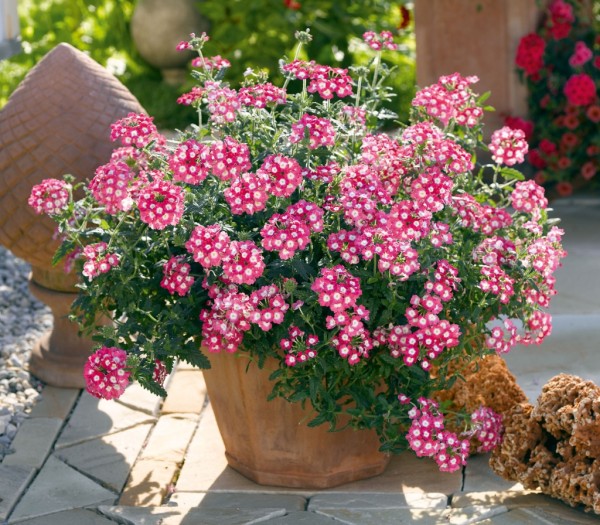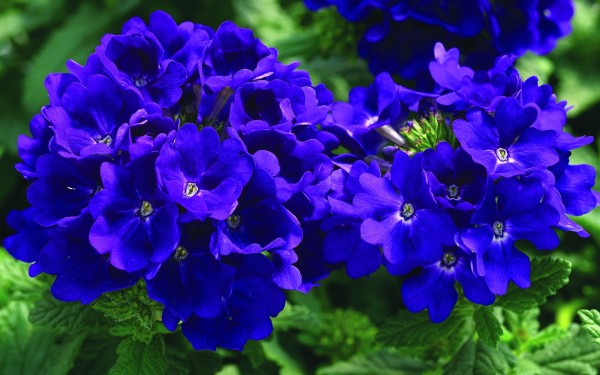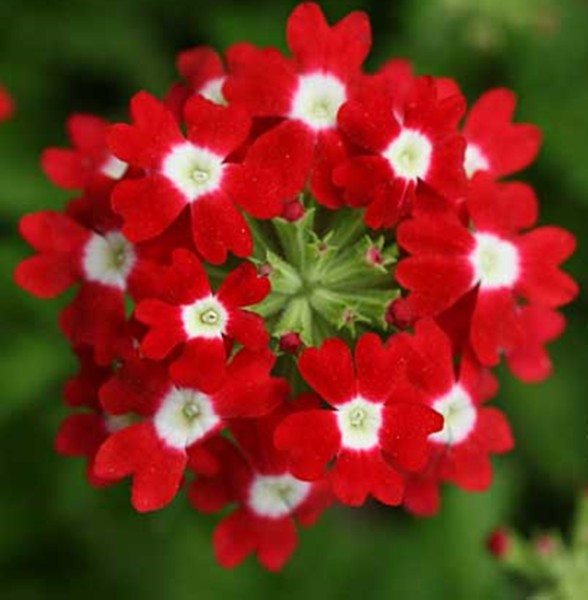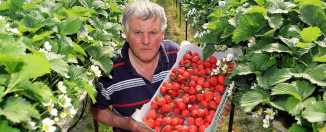Verbena: planting and care photos
Verbena has been known to man for many centuries. There was a time when this plant was surrounded by mysticism and mystery - love drinks were made from it and amulets for the family hearth were made. This flower is still often used in folk remedies.
Content
Planting verbena
It is only necessary to plant seedlings of this plant outdoors with the onset of stable warm weather. Verbena is unable to withstand long periods of temperature drop. The best place that you can find for a given flower, this is a well-lit space. Use nutrient-rich loam as a suitable soil. But in the absence of such, take a different soil, having previously mixed it with sand.
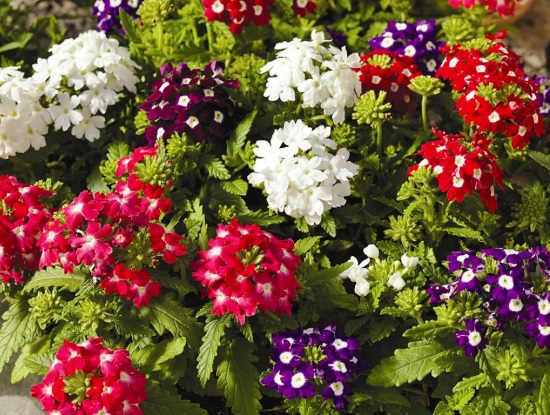 When planting verbena, it is necessary to maintain a distance of 20 to 30 centimeters between plants, focusing on the compactness of the variety. Before landing it is necessary to dig holes and put drainage in each. This will prevent the water from stagnating at the roots. The soil must be moist when planting. With dry soil, it is necessary to add water to the hole and only then place a verbena bush in it. Fill the hole with soil and press lightly around the plant bush. If planting is done after rain, no water should be added.
When planting verbena, it is necessary to maintain a distance of 20 to 30 centimeters between plants, focusing on the compactness of the variety. Before landing it is necessary to dig holes and put drainage in each. This will prevent the water from stagnating at the roots. The soil must be moist when planting. With dry soil, it is necessary to add water to the hole and only then place a verbena bush in it. Fill the hole with soil and press lightly around the plant bush. If planting is done after rain, no water should be added.
Verbena varieties
Now in nature, there are more than 250 different varieties of verbena. The most popular are the following varieties:
- Verbena hybrid is a small bush with rounded leaves, which are covered with small villi. Flowers are collected in small inflorescences of various colors.
- Canadian verbena has small bushes that grow no higher than 20 cm. It has delicate leaves and brightly colored flowers, collected in inflorescences in the form of bunches. Shades of flowers from lilac to white.
- Buenos Airesian verbena, on the other hand, is a tall plant. It can grow to a height of 1 m. The color of the flowers of this variety is pink-purple.
- In hanging pots or baskets, ampelnu verbena is grown. This plant is particularly resistant to disease.
Homemade verbena
Home is the best grow compact varieties of verbena that form small bushes. The conditions for keeping home vervain do not differ in special requirements. It is important to provide a moist soil for the plant so that it does not dry out. It is best to water the verbena from the bottom, that is, pour water into the tray on which the pot with the plant stands. From the middle of summer, it is worth reducing the amount of watering.
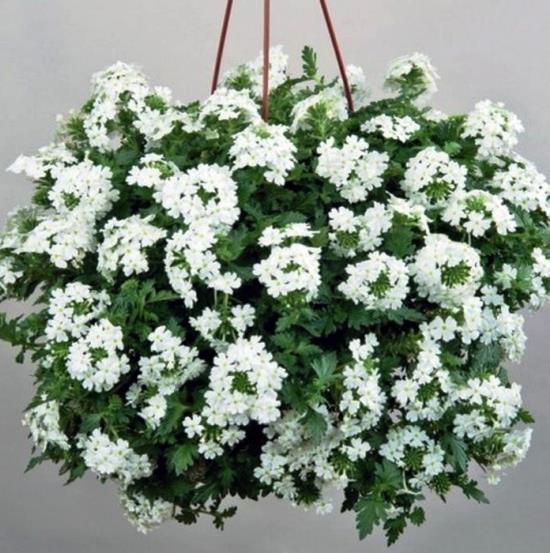 For feeding, use mineral fertilizers twice a month. You can feed the plant with organic fertilizers, but not more than once during the whole summer. If you do this dressing more often, then the plant will stop blooming due to excess nitrogen and will focus on the development of green mass.
For feeding, use mineral fertilizers twice a month. You can feed the plant with organic fertilizers, but not more than once during the whole summer. If you do this dressing more often, then the plant will stop blooming due to excess nitrogen and will focus on the development of green mass.
Sometimes the plant may need a transplant. In this case, it is necessary to take loose soil rich in mineral components for transplantation. But since the flower is distinguished by the compactness of the root system, a transplant is required in exceptional cases.
Verbena care
This plant is very unpretentious, it does not require any special keeping conditions. You must provide her with watering, top dressing and regular tillage. Verbena is very resistant to pests and diseases. Therefore, with a normal density of arrangement and avoiding excessive moisture, such problems will not affect you.
Vervain must be weeded throughout the growing season if it grows alone. With a group arrangement of plants, weeding should be carried out only at the first time. Soon, the bushes will grow well enough and no more weeding is required.
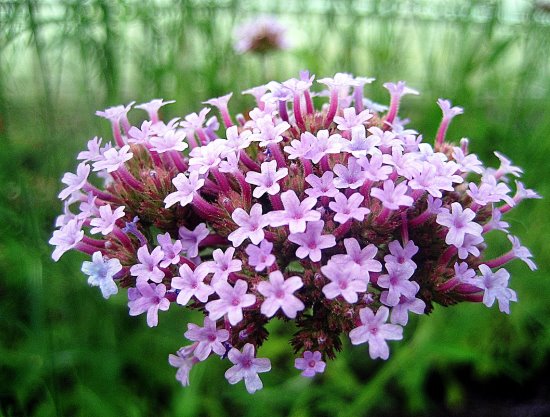 It is also not necessary to constantly loosen the soil around the plant. If the weather is very hot, then after watering it is necessary to slightly fluff the soil in order to allow air to the root system. Cover the soil around the verbena with rotted leaves if necessary. This way you will avoid excess density and drying out of the soil.
It is also not necessary to constantly loosen the soil around the plant. If the weather is very hot, then after watering it is necessary to slightly fluff the soil in order to allow air to the root system. Cover the soil around the verbena with rotted leaves if necessary. This way you will avoid excess density and drying out of the soil.
During flowering and growth, vervain should be watered frequently. After mid-summer, the intensity of watering is reduced. It is necessary to feed the verbena with complex fertilizers. As for room verbena, you can apply organic fertilizer once a season. In this capacity, compost or manure is suitable.
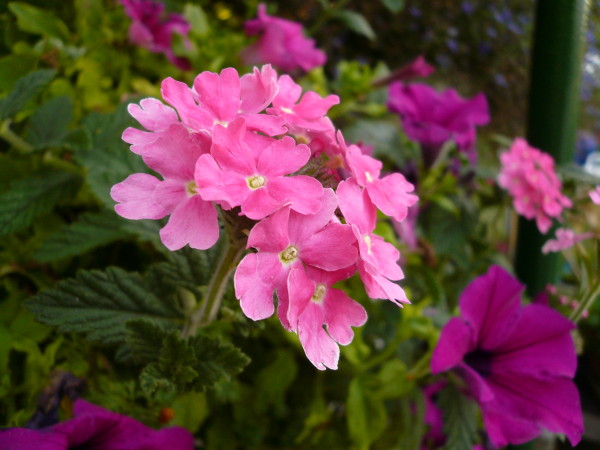 For breeding vervains use cuttings or simply plant the seeds of the plant. If you want to grow this plant from a cuttings, then worry about preparing the material in the fall. To do this, in the fall, dig up the verbena and move it to a cool room. For this, a basement, an extension to the house or an insulated balcony are suitable. In such a room, the temperature should not rise more than +10 degrees.
For breeding vervains use cuttings or simply plant the seeds of the plant. If you want to grow this plant from a cuttings, then worry about preparing the material in the fall. To do this, in the fall, dig up the verbena and move it to a cool room. For this, a basement, an extension to the house or an insulated balcony are suitable. In such a room, the temperature should not rise more than +10 degrees.
Cut cuttings from the bush in early spring. Take them from the top of the shoot. Each stalk must contain at least 4 pairs of leaves. Sprinkle the cut with crushed charcoal to disinfect. Then remove the leaves from the bottom, only leave the cutting on the top of the head.
Now prepare a mixture of sand and peat in equal amounts and root the cuttings in it. Lower the planting material into the ground until the line of the first pair of leaves removed. Cover the container with a film on top - this will create the necessary microclimate. After about a month, the root system of the cutting will be formed and it can be planted in a permanent place.
